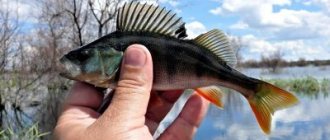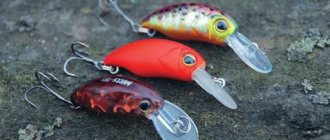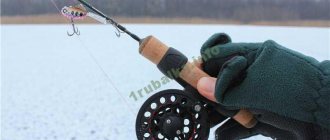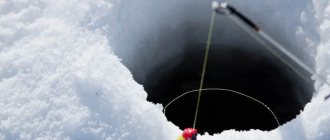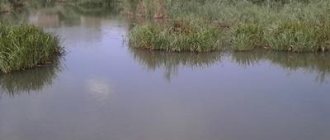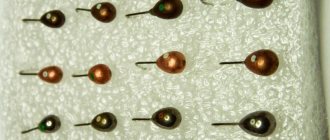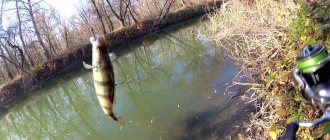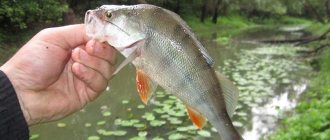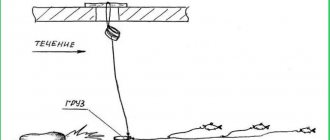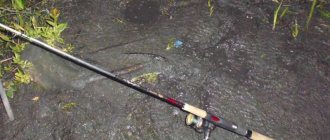Predator behavior in January
With the formation of a thick layer of ice, perches do not scour the entire water area of the reservoir in search of easy prey. They gather in small schools and stay close to the bottom.
The lower layers of water are less cold. There the temperature is constant - about + 4° C. And since fish are not warm-blooded animals, their body temperature directly depends on the temperature of the water and affects life processes: metabolism and metabolism. The colder the water, the slower the body absorbs the oxygen and food necessary for life. In addition, fish, being in austerity mode, need water saturated with oxygen in order to spend less energy on breathing.
Therefore, in January, the lack of oxygen in the water layers and the drop in temperature force the perch to lie in the pits almost motionless. But short feeding trips occur from time to time. Although the perch does not go far from its winter rookery. He does not want to leave his habitable place for the reason that he does not have the strength to make long journeys.
Perch fishing in February
Winter is coming to an end, and you need to have time to enjoy ice fishing one last time. But the presence of oxygen in reservoirs in February is so low that all the inhabitants of the reservoir are very lethargic and do not pay attention to the bait. But, as in other winter months, perch comes to the aid of the fisherman, which, even in such conditions, is distinguished by its gluttony.
Read! Tips for caring for your ice auger
Where to look for perch in February?
As you know, ice fishing depends 80 percent on the search for fish, and February is no exception. Perch loves high-quality water, so look for it in places where there is at least some source of oxygen: inflowing rivers and streams, springs, underwater snags and bushes, large riffles, etc. It should also be remembered that during the day most often the striped fish can be found at depth, and in the late afternoon - in shallow places.
The presence of a fry also signals that there is a perch somewhere nearby, since it would not be very wise for it to leave its food base during a difficult period. Therefore, if you come across a school of fry, then feel free to start fishing for perch near this place.
Where to look for perch in January
Upon arrival at the reservoir, you should look around and determine the wintering place of the perch. First, start fishing the coastal zone.
You should not look for perches where there were thickets of underwater grass in the summer. In these areas there is very little oxygen; rotting algae saturates the water with methane, which is unsuitable for breathing, and oxygen is taken from the water.
If there is enough oxygen in the water and the temperature is not lower than + 5°C, the prickly predator hunts close to the shore. It lies in ambush next to the reeds, at changes in depth and in places with cliffs and a hard bottom. At temperatures below five degrees, there is a chance to find perch at depth: in holes and other bottom depressions.
On a pond or lake, try fishing in places where a stream flows into the reservoir or underground springs flow. As a rule, perch always strive for fresh sources - they contain a large amount of oxygen.
Lovi-Rubky.ru
In January, by the middle of winter, the ice thickness in many reservoirs reaches its maximum, and all underwater inhabitants, including omnivorous perches, begin to experience a serious lack of oxygen, which negatively affects the bite.
Catching perch becomes truly difficult, because catching even a small number of previously well-biting sailors is not so easy. UPD: Angler's calendar for January The most important factor in successful fishing in January is the ability to find new sites for striped predators.
Since all the white fish, and after them the predators, leave previously suitable shelters for them - various kinds of snags and tree debris. In mid-January, holes made above snags often produce a foul, putrid odor, and this phenomenon alerts the fisherman to the low oxygen content in such a place. And we can safely say that all the fish have left this area. Therefore, it is rather futile to continue fishing in this place. You need to look for perch in areas where streams flow into a river or lake or where warm springs gush out. In such places, the water almost does not freeze all winter, and the oxygen level there is sufficient. And during periods of deep winter, there are a lot of different fish in the area of such places, including perch. On shallow floodplain lakes, in January, also due to a lack of oxygen, the perch bite is greatly reduced, but as soon as frost is replaced by at least a couple of days of thaw, the lakes wake up and present anglers with a real perch feast. At such times, baitless jigs perform especially well, since they most closely resemble the perch’s main food in such places—small underwater insects. Fishermen are in no hurry to use bloodworms or burdocks at such times, as they very strongly attract various small fish, which prevent larger fish from approaching. It is worth noting that in January, during periods of thaw, shallow river bays become quite promising. It is there that the surface of the ice is covered with a network of cracks that allow oxygen to pass through, and at shallow depths, about one and a half meters, the feeding of the perch begins. Yes, such that in one fishing trip you can fill your fishing box to the top with it! During such periods, fishermen give the palm to all kinds of “goats” and “devils.” Playing with them becomes very catchy with an average frequency of oscillations. In those years when winter goes the way it’s supposed to go, that is, Epiphany frosts crackle in January, wide river stretches with a fairly strong current can become very catchy spots. And it doesn’t hurt that the entire surface of the ice is often simply riddled with drilled holes that remain from previous ice battles. Perch stays there almost the entire winter period. But only a special approach to it in such periods is required. Using jig tackle with active play is not always justified - this often brings only a few undersized perches. But at the same time, as soon as the fisherman puts the fishing rod on the ice with a jig and a dung worm strung on its hook, a good bite of decent-sized perch immediately begins. And although the jig is motionless at the very bottom, the fish bites are sharp and confident. Here it is worth saying that at the beginning of fishing you should definitely check the place for the presence of a fast current, and if the current in the selected area is weak or absent at all, then most likely there will be no bites from the perch.
If you liked the article, share it with your friends! Thank you!
Features and subtleties of perch fishing in January
When going perch fishing in January, you need to take into account the weather conditions. It is better to fish on a windless January day with a slight frost. When the atmospheric pressure is constant, the predator is more active than in bad weather. The most promising time for catching a predator is thaw. At this time, he is more active than ever in January.
During the day, the intensity of the striped predator's bite may change. Sometimes he bites better in the morning, sometimes in the middle of the day or in the late afternoon.
When fishing, do not forget about the holes that were drilled first. Perhaps after a while there will be a perch under them. Therefore, it is worth returning to them. A few movements with a jig or spinner will not take much time, and the result may be positive.
In the middle of winter, in order to tempt an inactive predator to bite, you can experiment with lures. Instead of the classic game with a jig, it is worth offering the striped robber other options: tapping and moving along the bottom, slowly raising the spoon with long pauses. There is no need to make sudden movements with the tackle, as the January perch is sluggish and cautious. This may scare him away and he will leave the fishing area.
Perch in January – features of fishing tactics, technique and gear
With the onset of persistent cold weather, the mode of life of underwater inhabitants changes. Perch in January is no exception. The predator becomes generally less active, but this does not mean the cessation of biting. Throughout the winter, the striped pirate continues to feed, just not as actively as in the warm season. And if you approach the striped fish correctly, using the right tactics and fishing techniques, then the perch bites will not take long.
For us, January is the middle of winter. In the underwater world, this time is the end of the transition period from the smooth decay of activity after the first ice to the deep winter. Of course, all this also depends on the geographical location of the reservoir. In the regions of Siberia and the North, the wilderness is already in full swing, and in the south there are periods of thaws, sometimes long ones. Naturally, such a difference imposes specifics on the January behavior of underwater inhabitants.
What gear to use to catch perch in the middle of winter
Lures for perch fishing in January determine the choice of fishing gear. Catching jigs for perch, regular and baitless, require a winter fishing rod of the “filly” or “balalaika” type equipped with a reel. The reel can be built into the rod, which gives fishing some comfort.
A nod made of lavsan or metal can be used as a bite alarm. Its length should not be more than five to six centimeters. The fishing line is usually selected according to the expected size of the object being fished. Winter perches weighing up to two hundred and fifty grams do not offer strong resistance. For fishing them, a fishing line with a thickness of 0.06 or 0.08 mm is suitable; for larger ones, the thickness can be increased to 0.10 or 0.12 millimeters.
For fishing with spinners, you need winter hard rods with a nod-spring or a rubber signaling device made from a nipple. Some amateur fishermen prefer to fish with sensitive spinning rods up to one meter long. This gear is designed for ice fishing. It uses a 0.16 mm fishing line, since it is supposed to catch large perch. There are also fans of winter fishing who, instead of monofilament, successfully use braided cord 0.06 millimeters thick in such fishing rods. It is highly sensitive - the angler feels even light bites from a half-asleep perch.
In addition to active fishing with jigs and spoons, hunting for freshwater predators can also be carried out passively. To do this, they use a well-known tackle - a girder. It is somewhat different from the pike: it does not have a metal leash and the hook is much smaller in size. The baits are designed for catching large perches, the so-called humpbacks. Small minnows and bleaks are usually used as live bait, which large perches can swallow whole.
What does a bass angler need?
The angler's arsenal of perch fishing in January is small. Basically, this is a fishing rod with jig tackle and tackle used for vertical trolling; fishing rods configured for fishing with a float can also be used, but this is less common. Mostly fishing rods equipped with reels are used; such tackle is much more convenient to use, especially for those who like to catch perch.
The whip on the fishing rod should be at least 15cm long; this size will sufficiently create the necessary shock absorption when hooking and protect the line from breaking. Of course, small stripers can be caught with any fishing rod, but if there is even the slightest chance of catching a worthy specimen, then the tackle must be appropriate.
The diameter of the fishing line is generally selected within the range of 0.15mm, because thinner tackle brings more bites.
The nod should not be very hard and up to 10 cm long. It is important that the nod is correctly adjusted; it should only bend slightly under the weight of the jig, otherwise it will be very difficult to see the bite. Catching perch in January is much better and more effective if you use jig tackle, but there are some drawbacks. With the advent of the low season, the perch becomes very picky about lures and playing with them, he is more interested in a more sluggish game or even its complete stop; it is better to use a jig that is more voluminous, but not longer than 7 mm. “Devil” type jigs performed well. To increase the effectiveness of the jig, you can use multi-colored hairs tied to the fore-end.
We also recommend reading:
Fishing for pike perch in January 2021 Fishing for roach in January 2021 Fishing for crucian carp in January 2021 Fishing for pike in January 2019
The baits mainly used are bloodworms, dung worms, maggots, pieces of fish fillet, the eye of the perch itself, but to a greater extent fishermen use bloodworms.
Catching perch in January with a spinner is a little worse than with a jig, but still, it cannot be ruled out as an option. All luring always begins with a lot of work with an ice drill. A dozen holes are drilled, to begin with, in the direction from the shore and their fishing begins. If the perch does not find itself in any of the holes when trolling, then physical work should be continued, moving to the side 200 meters.
What to catch perch in January
In January, a special approach to fishing is needed, and therefore we will consider the nuances of fishing for perch during this period with different baits.
Jigs
To successfully catch perch in the middle of winter, you can use jigs with or without bloodworms. Among jigs with a natural attachment, the most popular are tackles in the form of a drop, a pellet, or a curved pellet called a “uralochka”. They work equally successfully depending on the appetizing nature of the bait attached to them. In this capacity, you can use maggots, pieces of earthworm, dragonfly larvae, poultry meat, fish fins and eyes and, of course, fresh bloodworms.
The second group includes various shaped jigs without a reel for perch, called goats, devils, witches, and all kinds of nail balls and nail cubes.
Fishing for perch in January with a jig requires the use of a special game. The movements should be smoother and less frequent, the more passive the striped predator behaves. It is important to be able to choose a jig game that will attract fish and force them to grab the bait.
The material used to make jigs is lead or tungsten. Tungsten jigs are more in demand among fishermen, since, compared to lead ones, their weight is less and the same size. This gives them smooth movement in the aquatic environment. For standing water at shallow depths, jigs weighing from two to three grams are suitable, for flowing water - heavier ones.
The color of the jig should be golden, black or silver. Such colors more often provoke perch to swallow the bait.
Spoons
Usually experienced anglers who are not interested in small perch catch perch using lures in the middle of winter. In winter, small fish do not hunt for large objects of food. Therefore, only large predators fall for the lure. For such fishing, spinners from one and a half to five centimeters long are used. They can be copper, brass and even silver. The tee of the spinner is decorated with a bunch of bright threads, multi-colored beads or cambrics.
In order for the spinner to play better horizontally, its center of gravity must be in the middle, and it itself must be wide. When fishing in pits, it is more advisable to use narrow spoons with a shifted center of gravity downwards. The so-called “maropeds” or “carnations”. This lure is better suited for vertical trolling at depth.
Balancers
A balancer is a bait that imitates the shape and movements of a fish. Its size depends on the size of the predator being caught - the larger the perch in the reservoir, the larger the balancer should be. Basically, baits with a length of two to five centimeters are used. The color, if perch fishing occurs at shallow depths, should correspond to the natural color of the simulated fish; if fishing at depth, it should be a bright acid color.
Rattlins
Rattlins are bladeless wobblers. They allow you to experiment with bait play, since there are several (usually three) attachment points on their back. Rattlins are used when catching large perch, because they were originally designed for catching not perch, but pike perch. You can also catch perch using amphipods from the ice, and this bait shows good results in the middle of winter.
Features of catching perch with artificial baits
• Fishing with a jig. Using this bait gives the best results, but success will largely depend on the ability to choose the right bait in terms of weight, size, shape and color. Let us immediately note that a rigid nod 10-15 cm long should be installed on the tackle. Under the weight of the bait, the nod should not deviate more than 25 degrees, otherwise it will be difficult to notice a bite from a predator in a timely manner.
To catch perch in this period, you should select bulky jigs 4-5 mm long; jigs called “devil” work best for perch. You can increase the attractiveness of the bait if you tie a small amount of red woolen thread to the hook, which will emit bloodworm larvae.
Particular attention should be paid to playing with bait. The actions should not involve sudden movements, the jig should move slowly, it should be lifted from the bottom to a height of up to 30 cm, pauses must be made (5-10 seconds). The predator's bite mainly occurs during a pause at the top point, or as soon as the bait hits the bottom, forming a cloud of turbidity.
• Lure fishing. This type of bait is used in January mainly when catching an active predator, when its stopping place has been determined. You should start catching perch with a spoon from the shore, that is, from shallow water. If there are no predator bites, then you should move to the side at least 20-25 meters. You shouldn’t spend more than 10 minutes on one hole; we note that if a predator is present in the fishing area, you won’t have to wait long for it to bite.
For catching perch, it is recommended to select spinners up to 4 cm in length; regarding color, it is better to opt for white, red or combined options. In cloudy weather, perch more readily attacks light-colored baits, and in sunny weather, bright-colored lures. This point is important to remember and take into account when choosing bait regarding color shade.
During the fishing process, the bait should not be jerked sharply, all movements should be smooth, only in this case it will be possible to attract and provoke the predator to attack. The bait needs to be torn off the bottom to a height of up to 20 cm, and when lifting it is necessary to pause (2-4 seconds). At the top point, the pause can be increased to 10 seconds. It is often possible to attract perch by lightly twitching the spoon directly on the surface of the bottom or a few centimeters from it.
Bait for a predator
You need to feed perch in January where it has shown at least some activity. The purpose of this action is to collect more fish near the hole and force it to start feeding. You shouldn’t throw a lot of food into the hole: just a pinch of some tasty bait is enough.
On reservoirs with a current, you can place the mixture in a feeder and secure it to the bottom above the fishing spot. The calculation is simple - the bait will be washed out and a feeding area will be formed in the place where the lure is cast.
As winter bait for perch, you can use ready-made mixtures purchased in stores, homemade bait with the addition of bloodworms or animal ingredients, a jar of fry lowered to the bottom, a punctured rubber glove filled with blood, and much more.
Timing
The best time to catch perch in January is during the thaw. When the air temperature, and then the water temperature, rises, the fish become more active. It is also preferable that the weather be stable for at least a few days. In bad weather with strong winds and precipitation, you can’t count on a good bite.
In January, minke whales are caught throughout the daylight hours. At the same time, you can count on maximum fish activity in its middle - that is, around 12-15 hours.
